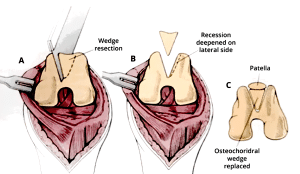Patellar Luxation
Back to Fact Sheets
Information for pet owners on patellar luxation in dogs, from diagnosis to treatment.
Download PDF
Patellar luxation is an orthopaedic condition which can affect any dog breed. It occurs when the kneecap dislocates out of the femoral groove. The consequence of this luxation is an inability to extend the knee joint, causing a limp.
What is patellar luxation?
The patella (kneecap) is one of the bones of the knee which sits in the groove on the bottom of the femur. It allows animals and humans to flex and extend the knee while sliding up and down in the groove.
Patellar luxation is an orthopaedic condition seen when the kneecap dislocates out of the femoral groove. The consequence of this luxation is an inability to extend the knee joint, causing a limp.
Although this condition can affect any dog breed, it is more commonly seen in certain breeds, especially toy or miniature breed dogs such as Yorkshire Terriers, Chihuahuas, Jack Russell Terriers, Pomeranians or Pekinese.
How is patellar luxation diagnosed?
Affected animals may be clinically normal or may exhibit lameness, which is sometimes described as intermittent lameness (skipping lameness). They can show a sudden and marked lameness which resolves when the patella goes back into its normal position. Sometimes, the patella stays permanently luxated and, in these cases, animals will show a permanent stiff and awkward gait.
There are different grades of patellar luxation based on how mobile the kneecap is relative to the femoral groove:
- Grade 1: The patella can be luxated with manual pressure but returns into the groove instantaneously. The patient usually does not show any clinical signs.
- Grade 2: The patella periodically luxates. This grade is typically associated with a skipping lameness when the kneecap moves.
- Grade 3: The patella is permanently luxated but can be manually replaced in the groove. The patient usually shows an awkward gait.
- Grade 4: The patella is permanently luxated and cannot be manually replaced in the groove. The patient is usually severely debilitated.
What are the consequences of patellar luxation?
When the patella moves out of the groove, it may damage the cartilage on its joint surface because it is not articulating correctly. This causes pain and triggers the development of progressive osteoarthritis. This will cause a decrease of mobility and pain eventually. Long-term problems will depend on the grade of the luxation and if both legs are affected to the same degree (50% of affected dogs have both knees affected). Dogs without any symptoms (grade 1 patellar luxation and some grade 2) can tolerate the condition without any problem for their entire life. However, unfortunately the grade of patellar luxation can change over time.
How can patellar luxation be treated?
Not all animals with this condition require surgical correction. Most of the animals with grade 1, and a few animals with grade 2, do not require surgery and can be treated conservatively – unless there are also other problems with the knee. Conservative treatment may include body weight management, physiotherapy, controlled exercise and medication (anti-inflammatories and pain killers).
Surgical treatment is strongly recommended in dogs with grade 3-4 patellar luxation and in dogs with grade 2 patellar luxation when it is associated with a persistent lameness. To correct this problem, various procedures can be used separately or in combination.
- Sulcoplasty: The groove of the femur is usually shallow in these patients. This technique is performed to deepen the groove, removing a wedge or a block of the cartilage and bone, which is replaced in a deeper position.

- Tibial tuberosity transposition: This is the most important part of the surgery. Patients with patellar luxation present with an incorrect alignment of the axis of the limb. The goal of this technique is to realign the insertion of the tendon that is attached to the kneecap. To do so, the bone is cut with the tendon attached on it and fixed in a centered position with metallic implants (pins and wire).

- Soft tissue reconstruction: The goal is to tighten loose tissues and release tight tissues on each part of the knee in order to prevent the patella from luxating again.
- Corrective osteotomies: In some severe cases, the femur presents some deformity as well and cutting the bone may be required to realign the limb.
What is the prognosis?
Most of the patients have an excellent outcome once they have recovered from surgery. They usually resume normal activity about 2-3 months after surgery. However, if arthritis has already developed in the knee joint, your dog may experience intermittent pain in the leg and it may progress. Physiotherapy can be added if necessary. Recurrence of luxation can happen in cases of severe grade patellar luxation (most grade 4 become grade 1-2 after surgery).



